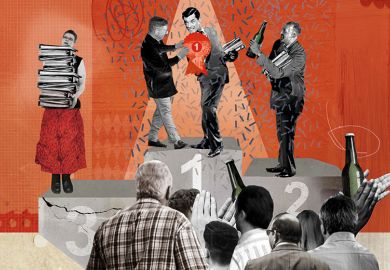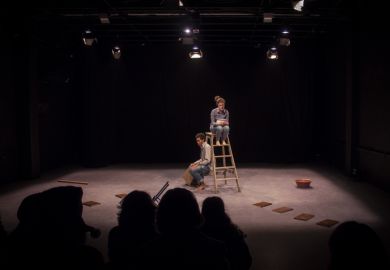Universities face profound issues, ranging from philosophical questions about higher education’s modern purpose to pragmatic plans for achieving sustainable growth. But institutions are not set up as well as they could be to resolve them. Compartmentalised operations, including the deepening divide between administrators and academics, render us unable to effectively address challenges that are bigger than one office, department or management strategy.
Consider graduation rates. Despite growing demand for higher education, and projections that by 2018, 63 per cent of jobs in the US will require education beyond high school, graduation rates fell last year for all US institution and student types. At least one in three people who start higher education programmes do not finish. Amid calls for universities to accommodate increasing numbers of global, tech-savvy students, there should be continued conversation about how to keep the students we enrol. At the start of each year, a meeting or email reminds us of the current graduation targets, and each year, we scatter to tackle a system-level goal like the proverbial blind men individually assessing an elephant.
Campuses teem with talent and ideas. The main obstacle is implementation. Entrenched management channels and operational inertia can saddle efforts of visionary educators. Arizona State University has embraced an effective solution to this problem, lean experimentation. This is a collaborative solution-design process that fosters interdisciplinarity and broad-mindedness. It embodies contemporary mantras of efficiency and productivity, enabling rapid implementation and testing to identify products and programmes worth continuing.
Lean experimentation is an extension of the “lean principles” long employed in the business realm and recently migrated to other industries such as healthcare and the non-profit sector, which provide critical services and aid without luxuries like time or – in the case of non-profits – stable incomes.
The core idea is to convene a team from different departments and backgrounds to probe a problem from numerous angles, drawing on their diverse and complementary perspectives and skills. Such diverse teams can assess the broader contexts of an issue and consider comprehensive, integrated solutions. For example, if the problem is student retention, a financial aid director and an academic adviser are likely to understand and address it differently, and can challenge each other’s assumptions about whether student loan support should end after enrolment, or whether publishing “maps” of the courses undergraduates intent on a particular major should take each semester is enough to keep them on track.
Lean experimentation also requires fully understanding the problem from users’ perspectives, so solutions centre on actual rather than perceived needs. Teams build a “minimum viable product” (MVP): the simplest possible model that can demonstrate their solution’s functionality, to test in real-world conditions. For example, if commuter students have particularly high dropout rates, the student retention team might conduct interviews and learn that they commonly lack solitary study space. The MVP could be a semester-long trial of expanded library quiet zones or reserved areas in local cafes.
The final phase of lean experimentation involves continuously measuring the solution’s effectiveness and revising it based on evidence and user feedback. This discourages design teams from hanging on too long or giving up too soon.
One example of the success of this approach is the online toolkit, eAdvisor, that Arizona State University has developed to bring together academic enrolment, class scheduling and student tracking. This allows students to get information about all the majors the university offers, see what classes they have taken and their grades, plan what courses to take each semester and connect to an adviser to discuss other majors that might suit them better or that would allow them to graduate within four years. Meanwhile, administrators can anticipate demand for classes and identify struggling students. Alerts are automatically sent to students who are “off track”, meaning that they are failing courses or are not taking enough courses required to complete their major.
The four-year graduation rate of the first eAdvisor cohort, which began in 2007-08, jumped by 9 per cent, and subsequent cohort rates continue to climb. Now members of the University Innovation Alliance, a group of 11 public research universities established to improve recruitment and retention by sharing successful programmes, are adopting and adapting eAdvisor to their own student populations. The benefits of trial-and-test methods amplify when institutions share their individually proven results. Alliance members are on track to produce an additional 100,000 graduates from 2014 to 2024, most of whom are low-income students.
Additional institutional benefits of lean experimentation, such as increased interdisciplinary regard and coordination, materialise regardless of the scale of the problem or solution. Dining halls might reimagine the student experience to attract customers and support healthy eating. Colleges might solicit faculty participants to test new curricular configurations, with a view to teaching skills such as communication, teamwork, critical thinking and reasoning that will allow students to “learn to learn” and ride the vagaries of the 21st-century job market.
Universities have a wide variation in their reverence for tradition, but all of them need to evolve alongside foundational shifts in the political and demographic fabric of nations. Lean experimentation is not a recipe for risk. Nor is it a call to forgo positive aspects of deliberation and stability for pure speed and agility. It is, instead, about addressing pressing problems creatively, embracing empathy and basing fateful investments on sound evidence. Is this not what universities are supposed to be all about?
Madison Sandy is a postdoctoral researcher in the College of Liberal Arts and Sciences at Arizona State University. In 2015-16, she was a University Innovation Fellow in ASU’s Office of University Initiatives, an ideas incubator and programme design hub.
POSTSCRIPT:
Print headline: Thinking fast and apropos
Register to continue
Why register?
- Registration is free and only takes a moment
- Once registered, you can read 3 articles a month
- Sign up for our newsletter
Subscribe
Or subscribe for unlimited access to:
- Unlimited access to news, views, insights & reviews
- Digital editions
- Digital access to THE’s university and college rankings analysis
Already registered or a current subscriber?








